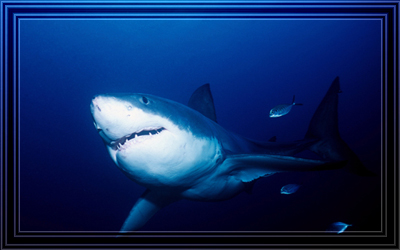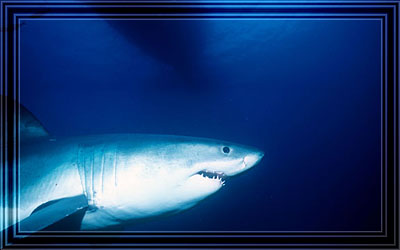Great White Sharks Secrets. . .
Yield to Research
|
By Carl Roessler
My recent cruise out of Adelaide, South Australia, was my 28th great white shark adventure. Time sure flies when you're having fun! Seriously, I have been deeply indebted over all those years to my friend Rodney Fox and his family for their knowledge and organizational skills to make diving with the sharks possible.

|
Rodney and his son, Andrew, have observed the behavior of great white sharks for nearly thirty years. During those years they (and I) have spun many educated guesses on shark behavior out of our personal experiences. For all our efforts, however, the sharks have remained elusive, and the complete masters of their secret lives.
|
For the first twenty years, for example, we always went out during February and March. The weather was warm, the winds usually light, the water conditions often excellent for photography. Yes, we often waited as the bait poured into the water for two or three days before the first sharks appeared. Nervous times, for sure. Still, all things considered, as far as we were concerned, February and March were the ideal season each year to get those classic pictures of great white sharks.
|
| Wrong. |
Recent research has now accumulated to indicate that the
sharks are far out off shore during Australia's Summer, and that in fact
the best time to find the sharks near the Neptune Islands is during the
July through September ( i.e., the Winter) period. This year, I utterly
enjoyed the luxury of having eleven different white sharks circulating
in the bay where we anchored for ten whole days of diving. |
One of these tagged sharks was well known to Rachel, a Phd. candidate who is completing her thesis on these sharks at the Neptunes. Working with Rodney and Andrew, Rachel is making detailed records of all shark appearances, and logging whatever actions each shark performs. In fact, Rachel has a $6,000 satellite recorder tag attached to Johnny (a fifteen footer) which will report six months of this shark's life when the tag uploads to it's satellite in February of 2003. |
Speaking of tagging great white sharks, Australian and American researchers have put electronic tags which are visible to tracking satellites in orbit above us on the backs and dorsal fins of a number of great whites. The results have been stunning to most of us old-timers. | 
| |
The initial young tagged male, Neale, blew apart our entire theory about how far individual great white sharks range. We had guessed for decades that the sharks we were seeing came from within perhaps a hundred miles of our anchorage. Instead, Neale made a few meandering loops around the islands, then swam slowly northeast along the coast for more than 500 miles! |
Worse, Neale was only the first stunner to rewrite the great white sharks owners‚ manual. Researchers in the U.S. have recently announced that many great whites migrate annually between the West Coast and Hawaii! |
All this has instilled a proper dose of humility into us and other experts. Along with old chestnuts such as "Great whites can only swim at slow speeds" (Wrong!) and "With all their bulk, great whites couldn't possibly launch themselves clear of the water" (Also wrong!), their seasonal behavior, range and goodness knows what else are all being re-thought. |
We may never know all of the great white sharks‚ secrets. Perhaps that is best for both men and sharks in the end. |
Meanwhile, though, my excursions to South Australia
aboard the 170-foot Falie with the Fox family will be the annual
adrenaline rush of each year. |
| 
| This year, the fabled 14-foot female named Curly made literally hundreds of close passes within a few feet of our divers. Rather than intently hunting us, she seemed instead to be as curious about us as we were about her. There have been few sharks in all my years of visits who were as persistent or came as close. | |
And yet, one day when Curly was elsewhere, a young male named K3 put on an eerily similar performance. K3 circled us constantly during a series of elevator cage dives to the bottom at 60 feet. Why? Was K3 active because Curly was away (the pecking order at work)? Had K3 observed Curly's technique from a distance when we couldn't see him? |
That all means the good news is, I'll just have to go back to South Australia next year to learn more! |


